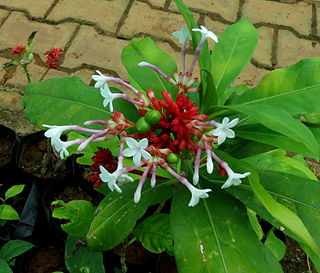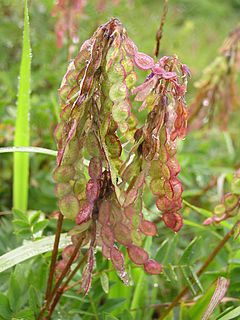
Apocynaceae is a family of flowering plants that includes trees, shrubs, herbs, stem succulents, and vines, commonly known as the dogbane family, because some taxa were used as dog poison Members of the family are native to the European, Asian, African, Australian, and American tropics or subtropics, with some temperate members. The former family Asclepiadaceae is considered a subfamily of Apocynaceae and contains 348 genera. A list of Apocynaceae genera may be found here.

Medicinal plants, also called medicinal herbs, have been discovered and used in traditional medicine practices since prehistoric times. Plants synthesize hundreds of chemical compounds for various functions, including defense and protection against insects, fungi, diseases, and herbivorous mammals.

Rauvolfia serpentina, the Indian snakeroot, devil pepper, or serpentine wood, is a species of flower in the milkweed family Apocynaceae. It is native to the Indian subcontinent and East Asia.

Desmodium is a genus of plants in the legume family Fabaceae, sometimes called tick-trefoil, tick clover, hitch hikers or beggar lice. There are dozens of species and the delimitation of the genus has shifted much over time.

Catharanthus roseus, commonly known as bright eyes, Cape periwinkle, graveyard plant, Madagascar periwinkle, old maid, pink periwinkle, rose periwinkle, is a species of flowering plant in the family Apocynaceae. It is native and endemic to Madagascar, but grown elsewhere as an ornamental and medicinal plant. It is a source of the drugs vincristine and vinblastine, used to treat cancer. It was formerly included in the genus Vinca as Vinca rosea.

A loment is a type of dehiscent legume fruit that breaks apart at constrictions occurring between segments, so that each segment contains one seed. It is a type of schizocarp.

Striga asiatica, the Asiatic witchweed or the red witchweed, is a hemiparasitic plant in the family Orobanchaceae. It is native to Asia and sub-Saharan Africa, but has been introduced into other parts of the world including Australia and the United States. Asiatic witchweed is a serious agricultural pest, as it parasitises important crop species, including corn, rice, sorghum, and sugar cane, often causing substantial yield reductions.

Desmodium incanum, also known as known as creeping beggarweed, Spanish clover, or Spanish tick-trefoil is a perennial plant native to Central and South America. In Hawaiʻi it is known as kaʻimi or kaimi clover from the Hawaiian for. Initially introduced as forage crop around the world, it has spread to many places although it is no longer an important fodder crop. It is considered a weed both within and outside its native range. It has spread through Florida and across the southern USA into southern Texas and across many Pacific islands, including Hawaii.

Bernard Verdcourt was a biologist and taxonomist, most widely known as a botanist and latterly an honorary research fellow at the Royal Botanic Gardens, Kew in London. Prior to coming to Kew in 1964, he was associated with the East African Herbarium for 15 years. Although his best-known work probably consists of his many studies of the East African flora, he has also made extensive contributions relating to African terrestrial mollusks and to entomology. Dr. Verdcourt received the Linnean Medal for botany from the Linnean Society of London in 2000. His list of publications includes more than 1,000 scientific works. The standard author abbreviation Verdc. is used to indicate this person as the author when citing a botanical name.

Desmodium paniculatum, the panicled-leaf ticktrefoil, narrow-leaf tick-trefoil or panicled tickclover, is a perennial herb in the pea family, Fabaceae. Belonging to a nearly cosmopolitan genus, the panicled-leaf ticktrefoil is a common native to Eastern North America, ranging from Quebec to Florida and as far West as Texas, Nebraska, and Ontario. The sticky loment can be found in disturbed areas that receive plenty of light, such as roadsides, parks, and abandoned fields.

Hylodesmum is a genus of flowering plants in the family Fabaceae, sometimes called ticktrefoils or tick-trefoils. It is sometimes treated as part of Desmodium.

Boerhaavia diffusa is a species of flowering plant in the four o'clock family which is commonly known as punarnava, red spiderling, spreading hogweed, or tarvine. It is taken in herbal medicine for pain relief and other uses. The leaves of Boerhaavia diffusa are often used as a green vegetable in many parts of India.

The tribe Desmodieae is one of the subdivisions of the plant family Fabaceae. It is composed of two subtribes, Desmodiinae and Lespedezinae. Recent phylogenetics has this tribe nested within tribe Phaseoleae.

Hylodesmum glutinosum is a species of flowering plant in the family Fabaceae. Common names include large tick-trefoil, clustered-leaved tick-trefoil, large-flowered tick-clover, pointed tick-trefoil, beggar's lice and pointed-leaved tick-trefoil. It occurs in eastern Canada, the central and eastern United States, and northeastern Mexico.

Desmodium tweedyi is an herbaceous flowering plant in the pea family native to northern Texas and southern Oklahoma popularly known as "Tweedy's ticktrefoil" or "tick-clover." The legume or seed pod it produces has given the species its common names from its ability to cling to clothing. Along with other species in the Desmodium genus, D. tweedyi has become a candidate for soil enrichment, suppression of insect pests, mulch and green manure production, and making "good fodder for animals including bobwhite, turkey, grouse, deer, cattle and goats."

Grona is a genus in the flowering plant family Fabaceae. Its native range is worldwide tropics and subtropics.

Desmodium tortuosum, the twisted tick trefoil, dixie tick trefoil, tall tick clover, Florida beggarweed, and giant beggar weed, is a species of flowering plant in the family Fabaceae. It is native to Latin America, and widely introduced as a forage to much of the rest of the world's subtropics and tropics.




















